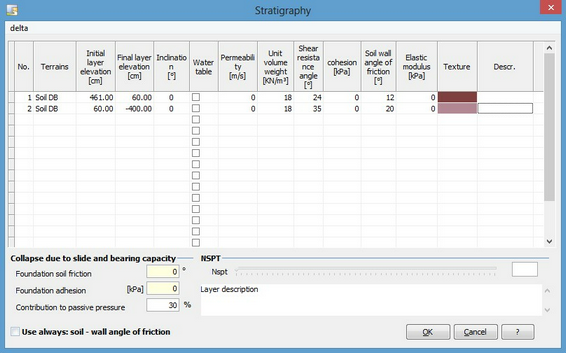|
Stratigraphy |

|

|

N.B.: Layers must be entered in sequence from the uppermost down.
Soil DB: The user can take advantage of a database of more common soils that is included in the program. To expand the scope of this database refer to Resource files from the Introduction.
Initial layer elevation [cm]: Height of upper level of layer. This will coincide with the lower level height of the previous layer (if any).
Final layer elevation [cm]: Height of lower level of layer. This will coincide with the upper level height of the next layer (if any).
Inclination layer [°]: Inclination of layer in respect of the horizontal.
Water Table: Check to indicate that layer is in contact with the water table so as to consider the thrust effect of water and the analysis of effective pressures. In such a case, please enter the total weight per unit volume.
k [m/s]: Layer permeability.
Unit Volume weight: Soil weight per unit volume.
Shear resistance angle [°]: Soil shear resistance angle; where water table is present enter the effective parameter.
Cohesion : Soil cohesion; where water table is present enter the effective parameter.
Soil wall angle of friction [°]: Soil-wall angle of friction.
Elastic Modulus: Elastic modulus of the layer. This is required to evaluate settlement where piles are involved.
Colour: Use colour palette to select colour that will denote this layer.
Description: Identifying description of the layer.
Fill: For fills on either side of the wall, it is required that: Soil weight per unit volume, Shear resistance angle, and Height be given in order to evaluate the stresses on the wall stem and foundation. The data is entered on a tab card at the right side of the screen.
In the global checks (load limits, overturning and sliding), the thrust is referred to a plane passing through the extrados of the founding upstream. Along this plane, the friction that develops in the presence of the shelf of founding is soil-soil friction and not soil-wall. Where, however, the foundation upstream is not present or is negligible, it is reasonable to assume that throughout the plan is to develop soil-wall friction, so the thrust evaluated with the theory of Coulomb is inclined the angle friction d of the soil-wall. In such cases it is possible to use the angle of soil-wall for global checks selecting this option down in the environment of definition of the stratigraphy.
|
|---|
© GeoStru Software